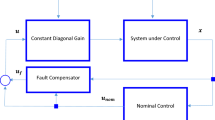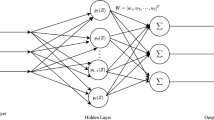Abstract
In order to accommodate actuator failures which are unknown in amplitude and time, adaptive fault-tolerant control schemes are proposed for automatic train operation system. Firstly a basic design scheme on the basis of direct adaptive control is considered. It is demonstrated that, when actuator failures occur, asymptotical speed and position tracking are guaranteed. Then a new user-friendly control scheme is proposed which can eliminate the undesirable chattering phenomenon, which is the defect of the previous method. Simulation results verify the effectiveness of established theoretical results that satisfactory speed tracking and position tracking can be guaranteed in the presence of uncertain actuator failures in automatic train operation systems.










Similar content being viewed by others
References
Pascoe R, Eichorn N (2009) What is communication-based train control. IEEE Veh Technol Mag 4(4):16–21
Dong H, Ning B, Cai B, Hou Z (2010) Automatic train control system development and simulation for high-speed railways. IEEE Circuits Syst Mag 10(2):6–18
Chen X, Zhang Y, Huang H (2010) Train speed control algorithm based on PID controller and single-neuron PID controller. Proc Second WRI Glob Congr Intell Syst 1:107–110
Dong H, Gao B, Ning B, Zhang Y (2010) Fuzzy-PID soft switching speed control of automatic train operation system. Control Decis 25(5):794–796, 800
Wang Y, Luo R, Yu Z, Ning B (2012) Study on ATO control algorithm with consideration of ATP speed limits. J Railw Soc 34(5):59–64
Luo R, Wang Y, Yu Z, Tang T (2012) Adaptive stopping control of urban rail vehicle. J Railw Soc 34(4):64–68
Yasunobu S, Miyamoto S, Ihara H (1983) Fuzzy control for automatic train operation system. In: Proceedings of 4th IFAC/IFIP/IFRS international conference on transportation systems, pp 33–39
Yasunobu S, Miyamoto S, Takaoka T, Ohshima H (1984) Application of predictive fuzzy control to automatic train operation controller. Proc IECON 84:657–662
Chang C, Xu D (2000) Differential evolution based tuning of fuzzy automatic train operation for mass rapid transit system. IEE Proc Electr Power Appl 147(3):206–212
Dong H, Gao S, Ning B, Li L (2013) Extended fuzzy logic controllers for high speed train. Neural Comput Appl 22(2):321–328
Howlett P (1996) Optimal strategies for the control of a train. Automatica 32(4):519–532
Howlett P, Cheng J (1997) Optimal driving strategies for a train on a track with continuously varying gradient. J Aust Math Soc Ser B Electron 38:388–410
Howlett P, Milroy I, Pudney P (1994) Energy-efficient train control. Control Eng Pract 2(2):193–200
Howlett P, Pudney P, Vu X (2009) Local energy minimization in optimal train control. Automatica 45(11):2692–2698
Liu R, Golovitcher I (2003) Energy-efficient operation of rail vehicles. Transp Res Part A 37:917–932
Yang C, Sun Y (2001) Mixed \({\cal H {\cal _{2}}/{\cal H} \cal _{\infty }}\) cruise controller design for high speed train. Int J Control 74(9):905–920
Wang C, Tang T, Luo R (2013) Study on iterative learning control in automatic train operation. J Railw Soc 35(3):48–52
Zhang X, Parisini T, Polycarpou MM (2004) Adaptive fault-tolerant control of nonlinear uncertain systems: an information-based diagnostic approach. IEEE Trans Autom Control 49(8):1259–1274
Gao X, Ovaska S, Wang X, Chow M (2008) A neural networks-based negative selection algorithm in fault diagnosis. Neural Comput Appl 17(1):91–98
Zargany F, Shahbazian M, Rad H (2013) Multi-sensor fault tolerant measurement based on Tagaki–Sugeno fuzzy model. Neural Comput Appl. doi:10.1007/s00521-012-1328-0
Wu Y, Sun F, Zheng J, Song Q (2010) A robust training algorithm of discrete-time MIMO RNN and application in fault tolerant control of robotic system. Neural Comput Appl 19(7):1013–1027
Zhuan X, Xia X (2010) Fault-tolerant control of heavy-haul trains. Veh Syst Dyn 48(6):705–735
Zhuan X, Xia X (2008) Speed regulation with measured output feedback in the control of heavy haul trains. Automatica 44(1):242–247
Tao T, Xu H (2013) Fault-tolerant control of high-speed trains with uncertain parameters and actuator failures using control reallocation and adaptive control. J Inf Comput Sci 10(7):1959–1977
Zhuan X, Xia X (2006) Cruise control scheduling of heavy haul trains. IEEE Trans Control Syst Technol 14(4):757–766
Zhou K, Doyle J, Glover K (1995) Robust and optimal control. Prentice Hall, NJ
Polycarpou M (1996) Stable adaptive neural control scheme for nonlinear systems. IEEE Trans Autom Control 41(3):447–451
Khalil H (2001) Nonlinear systems, 3rd edn. Prentice Hall, NJ
Spong MW (1992) On the robust control of robot manipulators. IEEE Trans Autom Control 37(11):1782–1786
Dawson DM, Carroll JJ, Schneider M (1994) Integrator backstepping control of a brush DC motor turning a robotic load. IEEE Trans Control Syst Technol 2(3):233–244
Ioannou P, Kokotovic PV (1983) Adaptive systems with reduced models, Lecture notes in control and information sciences. 47, Springer, New York
Ioannou P, Kokotovic PV (1984) Instability analysis and improvement of robustness of adaptive control. Automatica 20(5):583–594
Ioannou P, Sun J (1996) Robust adaptive control. Prentice Hall, NJ
Acknowledgments
This work is supported jointly by the Fundamental Research Funds for Central Universities (No. 2013JBZ007), National Natural Science Foundation of China (No. 61322307, No. 61304157, No. 61304196) and Beijing Jiaotong University Research Program (No. RCS2012ZZ003). Part of this work was completed while Mr. Shigen Gao was Visiting Research Student in University of Birmingham, and the financial support of China Scholarship Council is gratefully appreciated.
Author information
Authors and Affiliations
Corresponding author
Rights and permissions
About this article
Cite this article
Gao, S., Dong, H., Ning, B. et al. Adaptive fault-tolerant automatic train operation using RBF neural networks. Neural Comput & Applic 26, 141–149 (2015). https://doi.org/10.1007/s00521-014-1705-y
Received:
Accepted:
Published:
Issue Date:
DOI: https://doi.org/10.1007/s00521-014-1705-y




